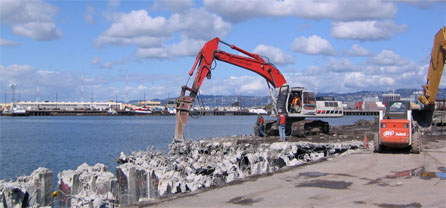
Marine Demolition
Not all demolition jobs are conveniently located: in fact, some projects are located far within the depths of the sea! Bedrock often needs to be demolished to harvest materials like:
- Precious ores
- Precious minerals
- Precious gems
- Artifacts
Things that are harvested can be processed into anything from steel girders to medicine. Materials that oilrigs and science labs are can degrade with time exposed to salt water and underwater currents. In cases of structural integrity breach, the safest thing to do is demolish them. Marine demolition is a complex process requiring nothing but the most skilled teams.
Underwater Explosives: Not Just for the SEALs
As many know, the Navy SEALs are the most elite fighting force across the globe training through unreal amounts of sleep deprivation, physical conditioning and training. What many don’t know is that the SEALs were formed as to specialize in marine demolition. While the SEALs underwater demolition experience generally deals directly with sabotage and covert operations, there are practical, business uses for underwater demolition teams and equipment. For instance, old oilrigs that have pumped their last ounces of black gold need to be demolished and removed from the sea but a significant portion of the foundation of such rigs are found hundreds of feet below sea level. Specially designed with an encasement of chemicals that form a rigid, gelatinous membrane around explosive material, underwater explosives are just as powerful as TNT and SEALs have direct experience mixing, planting and detonating such explosives.
Practical Applications of Marine Demolition
Most often, underwater demolition is used when there is a significant amount of bedrock or concrete foundation material of structures like oilrigs that needs to be blown away and removed. Getting to ore beneath bedrock and destroying concrete is simplified using a powerful explosive but there are other substances used when demolishing structures underwater. For instance, to cut through steel I-beams used in the construction of oilrigs, Thermite is often used which when “detonated”, heats to extreme temperatures hot enough to melt metal. Sea labs are often constructed underwater for research purposes. When research has run its course and the lab has grown unreliable with degradation after years, these structures are demolished similarly to structures above sea level. Placement of explosive charges throughout the structure will cause it to topple under its own weight.
Turning an Already Risky Job Riskier
Demolition work is already a huge risk even when it’s on land: performing underwater demolition requires a skilled team that has experience not only in demolition but also diving. Scuba certified individuals with thousands of hours of diving time may not even be considered without experience in demolition. Professional demolition workers can’t get near underwater projects without years of diving under their belt. Because the job is done underwater, the team must be acclimated to extremely cold water diving and they must know exactly how to surface and take corrective action if something goes wrong with their equipment. Though risks are high, payoff is great: underwater demolition experts make bank!
